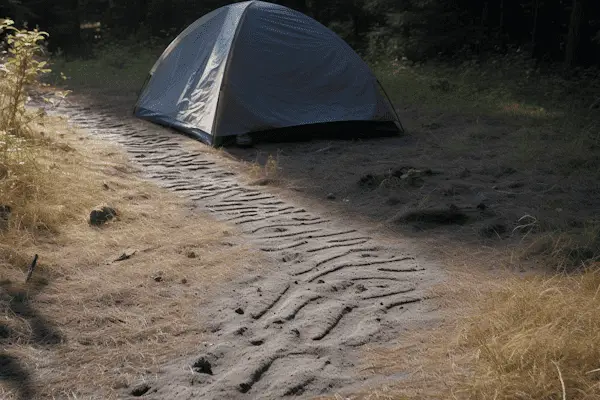The term tent footprint is thrown around a lot on camping and backpacking websites but what is a tent footprint really?
A tent footprint is a protective layer placed under a tent to prevent wear and tear from the ground. It shields the tent base from dampness, sharp objects, and dirt, extending the lifespan of the tent.

The Basics
In the simplest terms, think of a tent footprint as a sort of guardian for your tent. It’s like a secondary, tougher floor that’s specially designed to handle the harsh realities of the great outdoors. It’s a protective layer that you place underneath your tent. Why, you ask? Well, the ground you’re pitching your tent on can be unpredictable, filled with rocks, twigs, and all sorts of stuff that could potentially damage your tent’s floor. And that’s where a tent footprint comes in!
This trusty camping companion acts like a buffer, taking on those rough edges, sharp objects, and even dampness. It’s the shield to your tent’s delicate floor, and if you’re someone who’s planning on camping more than once, it can be a real lifesaver. It’s like giving your tent an extra lease on life, protecting it from unnecessary wear and tear.
So that, in essence, is what a tent footprint is all about. It’s not just about comfort; it’s about ensuring the longevity of your tent and enhancing your overall camping experience.
How Do You Use a Tent Footprint
Before you pitch your tent, you’ll lay the footprint on the ground first. Here’s a pro tip: ensure that the footprint is aligned correctly and is entirely covered by your tent. If parts of it are sticking out, they could actually channel rainwater under your tent rather than keeping it away. Not the situation you want to be in, trust me!
Once you’ve got your footprint placed correctly, you pitch your tent right on top of it. The footprint acts as a protective barrier between your tent floor and the ground. Just imagine it as a sturdy, extra floor for your tent, the unsung hero saving your tent from all the rough-and-tumble stuff on the ground.
And there you have it! That’s pretty much all there is to using a tent footprint. So next time you go camping, don’t forget to pack this camping ally and use it wisely for a smoother, more enjoyable outdoor adventure!
When Do You Need A Tent Footprint
Now, let’s talk about when you actually need a tent footprint. Do you need it all the time? Or are there certain situations where it’s more essential?
The truth is, it depends on a few factors. If you’re camping on perfectly soft, smooth ground without a hint of rain in the forecast, you might decide to leave the footprint at home. However, such ideal conditions are, as we know, quite rare!
Generally, a tent footprint is pretty crucial if you’re camping in rough terrain, or in places where there might be sharp objects that could potentially damage your tent’s floor. It’s also a good idea to have one when camping in the rain, or if the ground is damp. The footprint provides an extra layer of protection against moisture seeping into your tent.

If you’re using a high-end tent or you’re planning on using the same tent for many trips, it’s wise to use a footprint to extend the lifespan of your tent. Just think of it as an insurance policy for your tent, protecting your investment and ensuring you can enjoy many more outdoor adventures.
So, in conclusion, while there may be some scenarios where you can go without it, a tent footprint is generally a good idea for most camping situations. It’s all about playing it safe and getting the most out of your camping gear!
How Much Does A Tent Footprint Weigh
The weight of a tent footprint will depend on its size and the material it’s made from. On average, they typically weigh between 9 to 16 ounces (that’s roughly 250 to 450 grams for those of you who prefer metric). But keep in mind, this can vary based on the footprint you choose.
It’s all about finding a balance. Lighter footprints are great for minimizing your backpack weight, which is a big plus if you’re going to be trekking long distances. But don’t forget durability – it’s important the footprint can withstand the elements and rough ground. Thankfully, many modern tent footprints are designed to be both lightweight and tough.
So when choosing a tent footprint, consider your own camping style and needs. If you’re more of a car camper and don’t need to worry about carrying weight, a heavier, more durable footprint might be just right. But if you’re trekking up mountains and across long trails, every gram will count, and a lighter tent footprint will be your best friend.
In conclusion, while a tent footprint does add a little to your load, its benefits often far outweigh the added grams. It’s a small price to pay for protecting your tent.
Here is a table that shows the average weights of some of the more popular tent footprint materials used today. I’ve included both ounces and grams to avoid the angry emails I always get from non-U.S. people when I don’t.
| Type of Tent Footprint | Average Weight (ounces) | Average Weight (grams) | Average Thickness (mm) |
|---|---|---|---|
| Polyester Footprint | 9 – 12 | 255 – 340 | 1.5 – 2.5 |
| Nylon Footprint | 10 – 14 | 283 – 397 | 1.0 – 2.0 |
| Polyethylene Footprint | 11 – 16 | 312 – 454 | 2.0 – 3.0 |
| Tyvek Footprint | 7 – 10 | 198 – 283 | 0.14 – 0.20 |
| Tarp Footprint | 14 – 20 | 397 – 567 | 0.25 – 0.50 |
This should give a good overview of the different types of tent footprints and their typical weights and thicknesses. Remember, the best choice for you depends on your specific camping needs and preferences.
How Much Does a Tent Footprint Cost
Now, let’s talk money: What’s the cost of a tent footprint? We all want to ensure our adventures don’t break the bank, right?
The cost of a tent footprint can vary quite a bit, depending on factors like the size, brand, and the material it’s made from. You can find budget-friendly options that cost around $20-$30, while premium models can go up to $50-$70 or even higher.
If you’re a casual camper who’s just getting started, a lower-cost footprint could be a good fit for you. They’re usually decent enough for basic protection against wear and tear. On the other hand, if you’re a seasoned outdoor enthusiast and camping is your second nature, investing in a high-quality, durable footprint may be a wise move. It might cost a bit more upfront, but it can pay off in the long run by providing superior protection and potentially extending the life of your tent.
In a nutshell, while the cost of a tent footprint can vary, it’s a small investment when you consider the potential cost of having to replace a damaged tent. So, it’s worth considering adding one to your camping kit. Just remember, the best footprint for you depends on your personal camping needs and budget. Shop around, do your research, and find the one that fits best for you.
How To Make Your Own Tent Footprint
Let’s jump right into it. To start, you’re going to need a piece of durable, waterproof material. A popular choice is a tarp or Tyvek, but you can explore other options based on your needs and what’s available. Just make sure it’s tough enough to withstand rough ground and waterproof to keep moisture at bay.
Measure your tent’s dimensions and cut your material slightly smaller than the outline of your tent floor. You want it to be a little smaller so that it doesn’t stick out from under your tent and collect rainwater.
After you’ve cut your material, you can add grommets to the corners. This step is optional, but it can be useful if you want to stake your footprint to the ground to prevent it from shifting. And that’s pretty much it! You now have a homemade tent footprint ready for your next camping trip.
One of the great things about creating your own tent footprint is that you can customize it to your specific tent and camping needs. Plus, it can be quite cost-effective, especially if you camp frequently.
